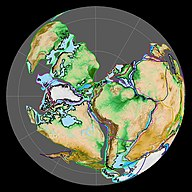Scientists theorize that supercontinents have formed in cycles throughout Earth's history. Pangaea was the most recent one, and it broke up approximately 200 million years ago. Some scientists believe we are in the middle of the formation of a new supercontinent that will include the mountains formerly known as the Mediterranean Sea.
This should not create anxiety. The movement of Earth's plates is very slow. It will be another 50 million years before the Mediterranean Sea disappears as the African Plate and the Eurasian plate join.
The Pangaea supercontinent existed during the late Paleozoic and early Mesozoic eras. Pangaea is the most recent supercontinent to have existed and the first to be reconstructed by geologists.
Rodinia (Russian родина, meaning "motherland" or "birthplace") was a Neoproterozoic supercontinent that assembled 1.1–0.9 billion years ago and broke up 750–633 million years ago. Rodinia's continental fragments reassembled to form Pannotia 633–573 million years ago (shown below).
Rodinia (Russian родина, meaning "motherland" or "birthplace") was a Neoproterozoic supercontinent that assembled 1.1–0.9 billion years ago and broke up 750–633 million years ago. Rodinia's continental fragments reassembled to form Pannotia 633–573 million years ago (shown below).
Pannotia was named by Powell (1995, University of Western Australia) based on the term "Pannotios" proposed by Stump in 1987 for "the cycle of tectonic activity common to the Gondwana continents that resulted in the formation of the supercontinent."
Another of Earth's supercontinents is called Columbia (Nuna or Hudsonland) and is thought to have existed approximately 2,500 to 1,500 million years ago in the Paleoproterozoic Era (from 2,500 to 1,600 million years ago). Zhao et al. 2002 proposed that the assembly of the supercontinent Columbia was completed by global-scale collisional events during 2.1–1.8 billion years ago. Other sources give 1,820–1,350 million years ago.
Columbia consisted of proto cratons that made up the cores of the continents of Laurentia, Baltica, Ukrainian Shield, Amazonian Shield, Australia, and possibly Siberia, North China, and Kalaharia as well.
Another of Earth's supercontinents is called Columbia (Nuna or Hudsonland) and is thought to have existed approximately 2,500 to 1,500 million years ago in the Paleoproterozoic Era (from 2,500 to 1,600 million years ago). Zhao et al. 2002 proposed that the assembly of the supercontinent Columbia was completed by global-scale collisional events during 2.1–1.8 billion years ago. Other sources give 1,820–1,350 million years ago.
Columbia consisted of proto cratons that made up the cores of the continents of Laurentia, Baltica, Ukrainian Shield, Amazonian Shield, Australia, and possibly Siberia, North China, and Kalaharia as well.
Kenorland was one of the earliest known supercontinents on Earth. It is thought to have formed during the Neoarchaean Era c. 2.72 billion years ago by the accretion of Neoarchaean cratons and the formation of new continental crust.



No comments:
Post a Comment